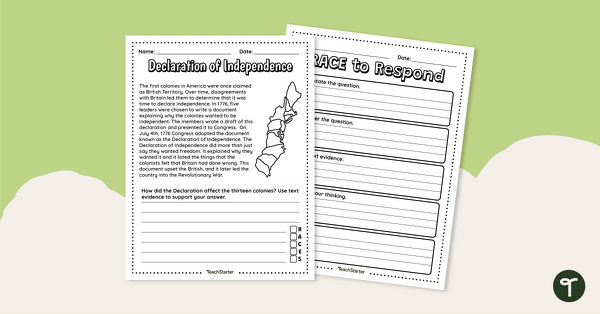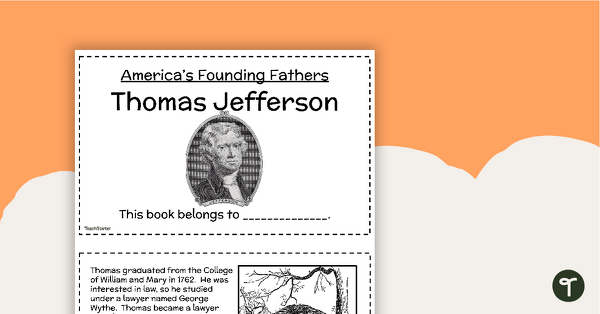13 Colonies Teaching Resources
Bring the 13 Colonies and Colonial American history to life in your elementary social studies classroom with printable worksheets, constructed response writing prompts, early US historical maps, digital social studies activities and everything else you need to teach about life in the original 13 colonies.
In this teacher-created collection, you’ll find printable 13 colonies maps, reading and writing worksheets, workbooks about the country’s founding fathers, Revolutionary War activities and more teaching resources by teachers for teachers.
Is this your first year teaching about Colonial America, or are you just looking for some fresh ideas? Read on for some tips from our teacher team, including a complete list of the original colonies, a student-friendly definition of colony, a handy list of the original 13 colonies and some more useful information for teaching about the colonial era to build your lesson plans.
What Is a Colony? A Kid-Friendly Definition
Depending on where you're teaching, you might be wading into the 13 colonies in third, fourth or fifth grade, and you'll have plenty of fresh vocabulary to teach. Let's start with the most obvious! Here's a kid-friendly way to explain the meaning of colony to students in those middle grades of elementary.
A colony is a place far away from a country where people from that country go to live and start a new community. Throughout history, colonies helped countries get resources and power, but they also affected the people and cultures already living in those places.
The 13 colonies are some of the most famous colonies that we talk about in social studies. That is a name we use to describe the settlements set up by British people on Native American land, land that we now call a part of the United States.
These colonies declared their independence from Great Britain and formed the United States of America in 1776.
What Were the 13 Colonies?
The specific 13 colonies (now American states) were:
- Virginia
- Massachusetts
- New Hampshire
- Maryland
- Connecticut
- Rhode Island
- Delaware
- North Carolina
- South Carolina
- New York
- New Jersey
- Pennsylvania
- Georgia
These colonies were established between the early 17th century and the mid-18th century, and all 13 were located along the eastern coast of what is now the US.
Each colony had its own unique characteristics and histories, but they were all British colonies up until the American Revolution gave them their independence.
How to Teach About the 13 Colonies: Fun Activities for the Classroom
There's a lot to cover when you're teaching about the growth of a nation!
This portion of the curriculum involves everything from developing student map skills to exploring the lives of the country’s Native peoples and the nation’s first visitors and exploring how a government is formed and a country is built.
Here are some Colonial America activities that can help cover the curriculum and get your students truly engaged with the nation's past!
Age Colonial Maps
Labeling maps of the various colonies with their names and their capital cities is one thing, but it gets a lot more fun when you pull out the coffee to dye student maps so they appear aged — just as they would if the dated back to the days when Samuel Adams wandered the cobblestones of Boston.
Create Secret Codes in Honor of Ben Franklin
Learning about key figures of the colonial era, like George Washington and Ben Franklin? Bring out the spy stories to get your students' attention!
Teach your class about the Culper Spy Ring — the group of American spies who worked for George Washington during the Revolutionary War — and explain Ben Franklin's time spent creating secret codes and ciphers for the group. Give each student a blank piece of paper and ask them to create their own secret code using symbols, numbers or letters.
Students can then use the codes to write short notes to their classmates, and their peers can work in pairs to decode the secret messages!
Create a Colonial Classroom Quilt
Assign a historical fiction reading assignment, allowing students to choose from a selection of books set during the Revolutionary War. When students have finished their books, have them design paper quilt squares with symbols that explain what their book is about. Put the squares together on your bulletin board to create a colonial classroom quilt!
Out "Witches" From the Days of the Salem Witch Trials
Teach students about the dangerous times during the Salem Witch trials with an activity designed to get them thinking — an in-class witch hunt. Hand each student a card that says whether or not they’re a witch. (The catch: no one is a witch).
Lead a class discussion on who your students think the witch might be. This is a great way to teach students how hysteria and finger-pointing can lead to chaos.
What Was the First Colony in America?
Of course, the British didn't start off in America with 13 colonies!
The first permanent English colony in America was Jamestown, founded in Virginia.
Jamestown was established in 1607 by the Virginia Company of London, a group of wealthy investors who hoped to make a profit from the resources of the New World. It would go on to play a key role in the development of the Virginia Colony, which would become one of the wealthiest and most influential colonies in North America.
Why Was Philadelphia Important in Colonial America?
Exploring some of the more important cities in the 13 colonies, Philadelphia will quickly come up. The Pennsylvania city hosted some of the United States' most important meetings in the precursor to nation's birth.
Here are just a few of the things that occurred in Philadelphia during the Colonial Era:
- The First Continental Congress — In 1774, delegates from 12 of the 13 British colonies gathered in Philadelphia to discuss their grievances against the British government.
- The Second Continental Congress — In 1775, the Second Continental Congress also met in Philadelphia. During this meeting, the delegates voted to establish the Continental Army and appointed future president George Washington as its commander-in-chief.
- The Signing of the Declaration of Independence — On July 4, 1776, the Continental Congress met in Philadelphia to sign the Declaration of Independence, declaring the 13 British colonies to be independent states.
13 Fun Facts About the 13 Colonies to Share With Your Students
Need some “fun facts” about the 13 colonies to spark your students’ interest and get them excited about learning all things colonial? Here are 13 facts that are kid-friendly and packed with an educational punch:
- The colonies were divided into three regions: New England, Middle, and Southern.
- The New England colonies included Massachusetts, Connecticut, Rhode Island, and New Hampshire. They were known for their rocky soil, cold winters, and strict religious beliefs.
- The Middle colonies included New York, New Jersey, Pennsylvania, and Delaware. They were known for their fertile soil, mild climate, and diverse populations.
- The Southern colonies included Maryland, Virginia, North Carolina, South Carolina, and Georgia. They were known for their warm climate, rich soil, and reliance on slavery.
- The first successful English colony in North America was Jamestown, Virginia, founded in 1607.
- Plymouth, Massachusetts was founded more than a decade later in 1620.
- Pennsylvania was founded by William Penn as a haven for Quakers, a religious group that was persecuted in England.
- The Middle colonies were known as the “breadbasket” of the colonies because they produced so much wheat, corn, and other grains.
- Maryland was founded as a safe haven for Catholics, who were persecuted in England.
- Georgia was founded as a buffer between South Carolina and what was then known as Spanish Florida.
- New Jersey was the name of a colony and is now the name of the state, but it also went by the name New Caesarea. That’s because the Isle of Jersey in Britian is believed to have been named after Caesar during the Roman times and was known as Caesarea (Insula), meaning Island of Ceasar.
- Many of the original 13 colonies had their own unique flag, some of which are still used today by the states that have formed in their place.
- In 1776, the 13 colonies declared their independence from Great Britain, leading to the formation of the United States of America.
- Plus Plan

13 Colonies Map - Blank
Build understanding of Colonial America with a blank 13 colonies map.
- Plus Plan

The New England Colonies - Instructional Slide Deck
Guide your students on a trip through American history with an instructional slide deck depicting life in the New England Colonies.
- Plus Plan

French and Indian War - Note Taking Template
Provide your learners with an organized method of note-taking with a French and Indian War note-taking template.
- Plus Plan

Social Studies Story Map - The French and Indian War
Combine literary plot diagrams and Social Studies standards with a French and Indian war story map worksheet.
- Plus Plan

French and Indian War - Brochure Project Template
Create a graphic summary of the French and Indian War with a brochure template.
- Plus Plan

The French and Indian War - Cloze Activity
Build vocabulary and understanding of the French and Indian War with a cloze reading passage worksheet.
- Plus Plan

The French and Indian War - Passage and Graphic Organizer
Reveal another chapter in American History with a reading passage and graphic organizer worksheet on the French and Indian War.
- Plus Plan

The Boston Massacre Reading and Writing Worksheets
Integrate Reading and Social Studies content with a set of Boston Massacre worksheets.
- Plus Plan

Boston Tea Party Worksheet Pack
Enhance your students' close reading strategies, vocabulary, and writing skills with a Boston Tea Party reading passage and accompanying activities.
- Plus Plan

Boston Massacre Passage and Writing Prompt Worksheet
Learn facts about the Boston Massacre with an informational reading passage and an informational writing prompt for fourth grade.
- Plus Plan

Benjamin Franklin - Constructed Response Worksheet
Learn facts about Benjamin Franklin with an informational reading and writing activity focusing on the constructed response format.
- Plus Plan

Paul Revere Worksheet - Constructed Response
Integrate reading, writing, and American history with a constructed response Paul Revere Worksheet highlighting the American Revolution.
- Plus Plan

Thirteen Colonies Brochure Project
Provide your students a 13 colonies project to end your unit on American colonization.
- Plus Plan

George Washington Printable Book
Read and learn about the father of our country, George Washington, with a printable reader and activity book.
- Plus Plan

Declaration of Independence- Constructed Response Passage Worksheet
Blend reading, writing, and historical concepts with the Declaration of Independence worksheet.
- Plus Plan

Thomas Jefferson Printable Mini-Book
Read and learn about Thomas Jefferson with a printable informational reader and activity booklet.
- Plus Plan

Alexander Hamilton Printable Mini Book
A mini-book about a Founding Father is the perfect tool for your students to use when learning about Alexander Hamilton.